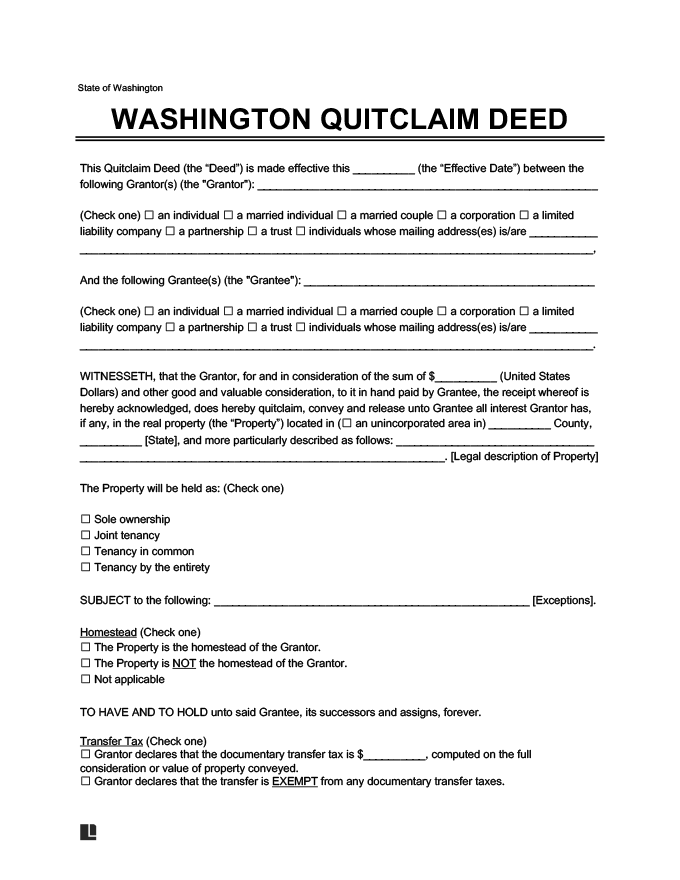In Washington, a quitclaim deed is beneficial for conducting more informal property conveyances. For example, an individual may use it to transfer property to their ex-spouse as part of a divorce proceeding or convey real estate as a gift to a close friend or family member. It’s essential to adhere to state-specific requirements when writing this document to ensure a court deems it valid.
Legal Framework
Quitclaim deed requirements are present in Tit. 64 (Real Property and Conveyances of the Revised Code of Washington. Wash Rev. Code 64.04.050 requires using the phrasing “conveys and quitclaims” from the grantor to the grantee. Later in the document, it’s wise to include “release and quitclaim” to further emphasize the document’s intent.
The information in Tit. 65 (Recording, Registration, and Legal Publication) governs the formatting and processes of all legal documents for public filing, including quitclaim deeds.
Legal Description
Wash. Rev. Code § 65.04.045 requires the quitclaim deed’s preparer to state the property’s address, Assessor’s Property Tax Parcel Number (APN), and an abbreviated legal description of the property. The APN must be distinct from the legal description and other text.
An abbreviated legal description of the property includes:
- Lot, block, plat, or section.
- Township, range, and quarter/quarter section.
- A reference to the later document page number where the full legal description is present (if applicable).
Signing
For a quitclaim deed to be legally binding in Washington state, the grantor must sign their name before a notary who acknowledges the signature (Wash. Rev. Code § 64.04.020).
Terminology
State laws provide the sample language to incorporate in a quitclaim deed, specifically in Wash. Rev. Code § 64.04.050. The deed should include the phrasing that the grantor “conveys and quitclaims all interest in the property” to the grantee. While this exact form is not required, every quitclaim deed should include the same substance.
Additional Documents
Per Wash. Rev. Code § 65.04.047, the grantor or preparer must provide a cover sheet if certain information isn’t present on the deed’s first page. If any of the following information appears later than the first page of your completed document, please prepare a cover sheet with this information:
- The grantor’s full name and address.
- The grantee’s full name and address.
- The title “Quitclaim.”
- A brief legal property description.
- The Assessor’s Property Tax Parcel Number (APN).
Filing
A completed quitclaim deed should be filed in the Washington recorder’s office for the municipality where the property is located (Wash. Rev. Code § 65.08.070).
Community Property
Washington’s community property law (Wash. Rev. Code § 26.16.030) states that neither spouse shall give community property without the implied or express consent of the other. Therefore, it’s crucial to state whether the property conveyed via a quitclaim deed is community or separate.
Validity Requirements
A quitclaim deed must follow specific formatting requirements as Wash. Rev. Code § 65.04.045 outlines:
- Include a three-inch top margin on the first page.
- Place one-inch margins on the bottoms and sides.
- Use one of two paper sizes, either letter (8.5 x 11) or legal (8.5 x 14).
- Use a font that is eight-point type or larger for readability purposes.
Please note that state law also forbids the following information from appearing in a deed: social security numbers, dates of birth identified with particular people, and maiden names of people’s parents to be identified with particular people.
Content Requirements
The content portion of a quitclaim deed must include the following:
- The grantor and grantee’s names and addresses.
- The title “Quitclaim.”
- The return name and address.
- A brief property description (a longer property description may accompany it if you attach it separately).
- The property address and APN (listed separately).
- A consideration clause noting the amount of money exchanged in the transfer.
- A description of the manner in which co-owners will hold title.
- A granting clause stating the transfer the parties have agreed to.
Quitclaim Deeds vs. Other Property Transfer Methods
| Quitclaim Deed | Provides a full warranty of title that includes all title issues, including those that existed before the grantor became the owner. |
| Bargain and Sale Deed | Provides a limited warranty of title and restricts the grantor's liability to the timeframe when they owned the property (Wash. Rev. Code 64.04.040). |
| Special Warranty Deed | Similar to a bargain-and-sale deed in that it offers a limited warranty of title that is restricted to the grantor's ownership period. The difference is that its restrictions aren't present in state statutes; instead, the warranty defines itself within the deed. |
| Life Estate Deed | Creates a relationship between the property owner (the life tenant) and the remainder beneficiaries who receive the property after the life tenant's death. They must collaborate to make selling and financing decisions while the life tenant is alive. |
| Transfer on Death Deed | Similar to a life estate deed, but the owner maintains full control and authority during their lifetime. |
